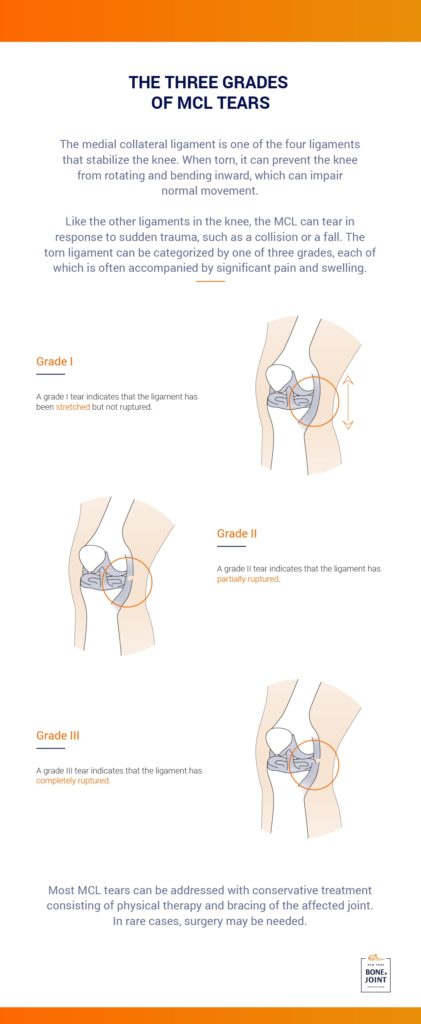A medial collateral ligament (MCL) tear in the knee may not be as well-known as an anterior cruciate ligament (ACL) tear, but it’s just as common among athletes who play football, soccer, basketball, or ski on the weekends. Many New Yorkers involved in recreational sports love the fast-paced nature of these activities, but the potential contact between players and sudden stops and pivots put their MCL at risk for injury.
MCL tear symptoms often appear immediately after the injury, sometimes with a pronounced popping sound in the knee. If you experience these symptoms, contact the expert orthopedic specialists at New York Bone & Joint Specialists. Take advantage of our skills and expertise to accurately diagnose an MCL tear and prescribe the most effective treatment.
We find that conservative therapy is highly successful in healing most MCL tears. When surgery is necessary for severe tears, our physicians are trained to perform minimally invasive procedures for optimal recovery.
Understanding MCL Tears: Your Knee’s Inner Support System
The MCL is one of four major ligaments that stabilize the knee joint. Located along the inner side of the knee, it connects the femur (thighbone) to the tibia (shinbone) and prevents the knee from bending too far inward while allowing normal rotation.
Due to its location and function, the MCL is susceptible to injury when excessive force is applied to the outside of the knee, causing the ligament to stretch or tear. MCL tears are most commonly the result of direct contact to the outer knee or sudden changes in direction that stress the inner knee structures. Because the MCL provides crucial stability to the knee joint, an injury to this ligament can cause significant instability and functional limitations.
MCL injuries are among the most common knee injuries, particularly in contact and pivoting sports. While professional athletes face the highest risk due to the intense nature of competition, weekend warriors and recreational athletes can also sustain MCL tears during activities like skiing, basketball, or even gym workouts involving heavy lifting.
MCL injuries are classified into three grades based on the severity of the tear:
- Grade 1: Mild stretching of the ligament with minimal fiber damage and no instability
- Grade 2: Partial tear of the ligament with moderate instability and functional limitation
- Grade 3: Complete tear of the ligament with significant instability and loss of function
MCL Tear Symptoms: Recognizing Knee Ligament Injury
MCL tears symptoms progress through stages, but usually start at the exact time of the injury.
Immediate symptoms after injury:
- Sharp pain on the inside of the knee
- Audible “pop” sound (in severe tears)
- Immediate swelling and tenderness
- Difficulty bearing weight
Progressive MCL tear symptoms:
- Pain with knee movement, especially bending
- Feeling of instability or knee “giving way”
- Tenderness along inner knee line
- Swelling that may persist for days
- Stiffness and reduced range of motion
Symptoms by grade:
Grade 1: Mild pain, minimal swelling, normal stability
Grade 2: Moderate pain, noticeable swelling, some instability
Grade 3: Severe pain, significant swelling, obvious instability. May occur with another injury, such as an ACL tear.
Functional limitations:
- Stiffness, tenderness, and a sense of instability in the affected knee
- A limited range of motion, particularly when moving laterally
- A locking or catching sensation when walking
- Problems with pivoting or cutting movements in sports
- Pain during daily activities like getting out of cars due to the twisting motion of the knee
Hearing a popping noise and experiencing immediate pain signal you need immediate medical attention to evaluate and treat an MCL tear. Severe pain and more severe symptoms could indicate the presence of other injuries in the knee.
MCL Tear vs Other Knee Injuries: Getting the Right Diagnosis and Treatment
MCL tears frequently occur alongside other knee injuries, making an accurate diagnosis essential for effective treatment. Understanding the differences between common knee injuries helps ensure appropriate care.
ACL vs. MCL Tear Differences
While both ACL and MCL tears can result from sports injuries or trauma, they affect different areas of the knee and have distinct characteristics:
Location and Function:
- The ACL runs through the center of the knee joint, preventing forward movement of the tibia
- The MCL runs along the inner side of the knee, preventing inward collapse
Symptoms and Pain Location:
- MCL tears cause pain and tenderness on the inner side of the knee
- ACL tears typically cause more generalized knee pain and a feeling of the knee “giving out” during pivoting
Healing Potential:
- The MCL has an excellent blood supply, allowing it to heal naturally with conservative treatment
- The ACL has poor blood supply and typically requires surgical reconstruction for complete tears
Treatment Approach:
- MCL tears respond well to conservative treatment in 90% of cases
- ACL tears often require surgical intervention for active individuals
Comprehensive MCL Tear Diagnosis
At New York Bone & Joint Specialists, our experienced orthopedic surgeons use advanced diagnostic techniques to accurately assess MCL injuries and develop optimal treatment plans.
Clinical Examination
Our comprehensive evaluation includes:
Medical History Review:
- Details of the injury mechanism and timing
- Assessment of symptoms and functional limitations
- Review of previous knee injuries or conditions
- Evaluation of activity level and goals
Physical Examination:
- Visual inspection for swelling, bruising, and deformity
- Palpation to locate areas of tenderness and assess tissue damage
- Range of motion testing to evaluate knee flexibility
- Stability testing using specialized maneuvers
Valgus Stress Test: This key diagnostic test evaluates MCL integrity:
- The patient lies comfortably on the examination table
- The examiner stabilizes the thigh while applying gentle inward pressure to the lower leg
- The test is performed with the knee at different angles (30 degrees and full extension)
- Excessive opening of the joint space or pain indicates MCL damage
- The degree of instability helps determine the severity of the tear
Advanced Imaging Studies
X-rays:
- Rule out bone fractures or avulsion injuries
- Assess overall joint alignment and structure
- May show chronic changes from previous injuries
MRI (Magnetic Resonance Imaging):
- Provides a detailed visualization of all soft tissues
- Accurately assesses the extent and location of MCL tears
- Identifies associated injuries to other ligaments, menisci, or cartilage
- Helps determine the optimal treatment approach
Stress X-rays:
- Specialized imaging is performed while applying stress to the joint
- Useful for evaluating the degree of instability
- Particularly helpful in assessing combined ligament injuries
At New York Bone & Joint Specialists, our state-of-the-art imaging capabilities allow for same-day diagnosis in most cases, enabling prompt initiation of appropriate treatment.
MCL Tear Treatment: From Conservative Care to Advanced Surgery
Conservative treatment for an MCL tear leads to a successful recovery within weeks. Grade I and 2 tears benefit the most from conservative therapy.
Conservative MCL Tear Treatment (Most Common Approach)
- Rest, ice, compression, elevation (RICE protocol)
- Using crutches if needed to avoid bearing weight on the knee
- Anti-inflammatory medications to reduce pain and swelling
- Hinged knee bracing for Grade 2-3 tears worn for four to six weeks.
- Physical therapy to gradually improve range of motion and strengthen the knee. Exercises will progress until you can return to sports. Depending on the severity of the tear, rehabilitation may last a week to eight weeks.
- Return to sports after four to six weeks of rest and physical therapy.
The grade of the tear dictates a general recovery timeline:
- Grade 1: Two to four weeks.
- Grade 2: Six to eight weeks.
- Grade 3: Eight to 12 weeks with special attention given to avoiding side-to-side activities until three to four after injury.
Surgical MCL Tear Treatment
Surgical intervention is rarely called for in an MCL tear. Yet there are instances when it may be the best option:
- Grade 3 tears with persistent instability and pain
- Conservative treatments have failed
- MCL tear combined with another injury, typically an ACL tear
- High-level athletes benefit most from surgery to return their knees to full function
Minimally Invasive Surgical techniques:
- The torn ligament is sewn together.
- The torn ligament is sutured to the bone to allow it to heal.
- Tissue from the patient or a donor bank replaces a badly damaged ligament.
MCL Tear Recovery Timeline
Initial healing: 2-3 weeks of protected weight-bearing
Early rehabilitation: 3-6 weeks of progressive physical therapy
Return to activities: 3-4 months for full activity clearance
Return to sports: 4-6 months with proper rehabilitation and clearance
MCL Tear Prevention: Protecting Your Knee Ligaments
While not all MCL tears can be prevented due to their often traumatic nature, several strategies can significantly reduce your risk of injury.
- Warm up. Do dynamic stretching, such as a brisk walk or climbing stairs. Do a hamstring stretch by lying on your back, bending your knee toward your chest, hold the joint from behind with both hands, and gently pull the leg toward you. Straighten the leg to the ceiling and bend it again.
- Strengthening exercises. Focus on building strength in the quadriceps, hamstrings, and calf muscles. Consider deadlifts, squats, walking lunges, and straight-leg raises.
- Follow proper form. Whether exercising or playing a sport, work with a trainer or coach to perfect your form and how to use gym equipment properly. When lifting weights, for example, maintain controlled movements and increase weights over time.
- Get the right gear. Purchase supportive shoes. Wear a knee brace while playing to keep the joint stable.
- Rest and recover. Rest between intense workouts or games. Give your ligaments and muscles time to heal.
Why Choose New York Bone & Joint Specialists for MCL Tear Treatment
When facing an MCL tear, choosing the right medical team can make the difference between optimal recovery and chronic problems. New York Bone & Joint Specialists offers comprehensive, expert care that addresses both immediate treatment needs and long-term joint health.
In addition to our knowledge and skills in treating MCL through traditional methods, we offer advanced MCL treatment options for you:
- Biologic treatments (Platelet-rich plasma injections, stem cell therapy)
- Advanced surgical reconstruction techniques
- Computer-assisted surgical techniques such as robotics when appropriate
- Accelerated rehabilitation protocols for active patients
- Return-to-sport testing and clearance
- Research participation opportunities
- Latest developments in MCL treatment
Frequently Asked Questions About MCL Tears
What does an MCL tear feel like and how do I know if I have one?
An MCL tear typically causes immediate sharp pain on the inside of your knee, often accompanied by a popping sound at the time of injury. You’ll likely experience swelling, tenderness along the inner edge of your knee, and a feeling of instability or that your knee might “give way.”
Unlike muscle strains that may develop gradually, MCL tears usually result from a specific incident like a direct blow to the outer knee or a twisting injury. The pain is typically worse with movement, especially bending or rotating the knee, and you may have difficulty bearing full weight on the leg. If you experience these symptoms, especially after a sports injury or fall, you should seek immediate medical evaluation.
What’s the difference between an ACL and MCL tear?
While both are knee ligament injuries with some similar symptoms like pain and instability, they affect different parts of your knee. An MCL tear causes pain and tenderness on the inside of your knee and results from forces that push the knee inward. An ACL tear typically causes more generalized knee pain and instability, particularly with pivoting movements, and often results from sudden changes in direction or awkward landings.
The key difference in treatment is that MCL tears have excellent healing potential due to good blood supply and respond well to conservative treatment in over 90% of cases. ACL tears, particularly complete ones, typically require surgical reconstruction because the ligament has a poor blood supply and cannot heal on its own.
How can I tell if I have a meniscus tear vs MCL tear?
While both injuries can occur together and share some symptoms, there are important distinctions. Meniscus tears often cause a locking or catching sensation in your knee, where it may feel “stuck” in certain positions or make clicking sounds during movement. The pain from a meniscus tear is usually deep within the joint and may worsen with twisting motions or when you squat down.
MCL tears cause pain specifically along the inner side of your knee and create a feeling of instability, like your knee might collapse inward. An MRI is the most reliable way to distinguish between these injuries, as the symptoms can overlap significantly. It’s also important to know that these injuries frequently occur together, requiring comprehensive evaluation by an orthopedic specialist.
How long does it take to recover from an MCL tear?
Recovery time depends on the severity of your MCL tear. Grade 1 (mild) tears typically heal within 2-4 weeks with proper conservative treatment. Grade 2 (moderate) tears usually require 4-8 weeks for complete recovery. Grade 3 (severe) tears take the longest, typically 8-12 weeks, and may require surgery in some cases.
Factors that affect your recovery include your age, overall health, adherence to treatment protocols, and activity goals. Athletes may need additional time for sport-specific rehabilitation before returning to competition. The key to optimal recovery is following your treatment plan completely, including physical therapy exercises, and not returning to activities too soon, which could lead to re-injury or chronic instability.
Do all MCL tears require surgery or can they heal on their own?
The vast majority of MCL tears can heal without surgery. The MCL has an excellent blood supply, which allows it to heal naturally with proper conservative treatment. Studies show that over 90% of isolated MCL tears heal successfully with rest, bracing, physical therapy, and activity modification.
Surgery is typically recommended only for Grade 3 tears that remain unstable after 8-12 weeks of conservative treatment, cases where the MCL is torn along with other ligaments (like the ACL), or for high-level athletes who require optimal knee stability for their sport. Even when surgery is needed, modern techniques offer excellent success rates of 85-95%. Your orthopedic specialist will determine the best treatment approach based on your specific injury, activity level, and healing response to conservative treatment.
Experiencing knee pain or suspect an MCL tear? Don’t wait – early treatment leads to the best outcomes.
Contact New York Bone & Joint Specialists today to schedule a consultation with our knee injury experts. Our team is ready to provide you with accurate diagnosis and effective treatment options tailored to your specific needs and goals. Call us or fill out our online form, and we’ll contact you within 5-10 minutes to schedule your appointment at one of our convenient NYC locations.













